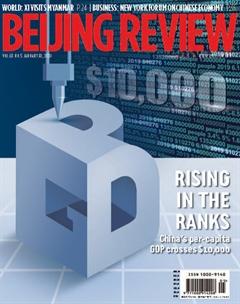A TRAP WITHIN A TRAP
By Ma Guangyuan
Chinas economy is entering a new stage after its per-capita GDP surpassed $10,000 in 2019, according to official figures released by the National Bureau of Statistics on January 17. This means that the country faces a critical moment as it confronts the challenge of escaping the so-called “middle-income trap” (MIT) and becoming a true high-income country.
The concept of the MIT was first raised by the World Bank in its report An East Asian Renaissance: Ideas for Economic Growth issued in 2007. According to its 2019 standard, those with gross national income (GNI) per capita of below $1,025 are considered low-income countries; those between $1,026 and $3,995 are lower middle-income economies; and those between $3,996 and $12,375 are upper middle-income economies. If a countrys GNI per capita is $12,376 or more, it is part of highincome countries. But if an economy stagnates at middle-income levels and fails to transit into a high-income economy, it will fall into the MIT. Although the concept of the MIT is widespread, in reality, it is not of high academic value or practical signifi cance.
Since World War II, only a small number of countries have actually joined high-income economies, as most countries have stagnated at middle-income levels. But the reasons for stagnation vary from country to country, and there is no evidence to prove such simplistic similarities.
There is also no rule to judge at what stage a countrys economy will stagnate. Among the nearly 200 countries and regions in the world, most have experienced high-speed growth, but the periods of high-speed growth are quite different, ranging from 10 to even 40 years. No proof is available to indicate that a countrys economy will begin to decline after reaching the level of high-income countries in Europe or the United States.
The history of economic development has shown again and again that no country can maintain high-speed growth forever, which makes perfect sense. With changes in economic volume, industrial structures and social conflicts, transition from high-speed to stable growth is normal, and economic slowdown doesnt mean a country has fallen into a trap.
An analysis of the reasons for stagnation after high-speed growth shows that stagnation is not inevitable, but is mainly caused by missing opportunities to reform income allocation, upgrade the industrial structure and implement overall reforms, hence closing the door to joining the group of high-income countries. Thus, it is inappropriate to call such stagnation an income trap.
China doesnt need to worry about the MIT; instead we must learn from countries in Latin America that stagnated and lost major opportunities to change the income allocation system, advance overall reforms and improve institutional building.
The MIT is actually a pseudo theory, since the real problems lie in how an economy responds to a new growth cycle, the challenge of an expanding income gap, the need to urgently upgrade its industrial structure, the transition of growth engines and reforms entering a deepwater zone.
Thus, if a countrys reform and institutional building can satisfy the demands of economic growth, pushing development forward, the country will not fall into the MIT.
For such a huge economy as China, after 40 years of high-speed growth, we should be well aware that an economic growth slowdown is normal. Chinas development has changed world economic and political landscapes, and it is natural that the world needs time to adapt to these changes. Now that it is stronger, the role China plays in the future development of the world economy and global governance will be crucial.
It is important for China to recognize that in the next economic cycle, its growth rate, industrial structure, growth engines and institutional framework for economic governance will be vastly different from those over the past four decades. Therefore, it needs to respond vigorously with its reform and institutional building, which will be the key to escaping the MIT.
Looking forward, intensifying reform is still the consensus throughout China, while all agree that institutional building will lead to the modernization of governance capacity. Thus, reform should be enhanced and breakthroughs made in different fi elds in order to seize the opportunities of economic growth in the next cycle and maintain sound and steady development.

